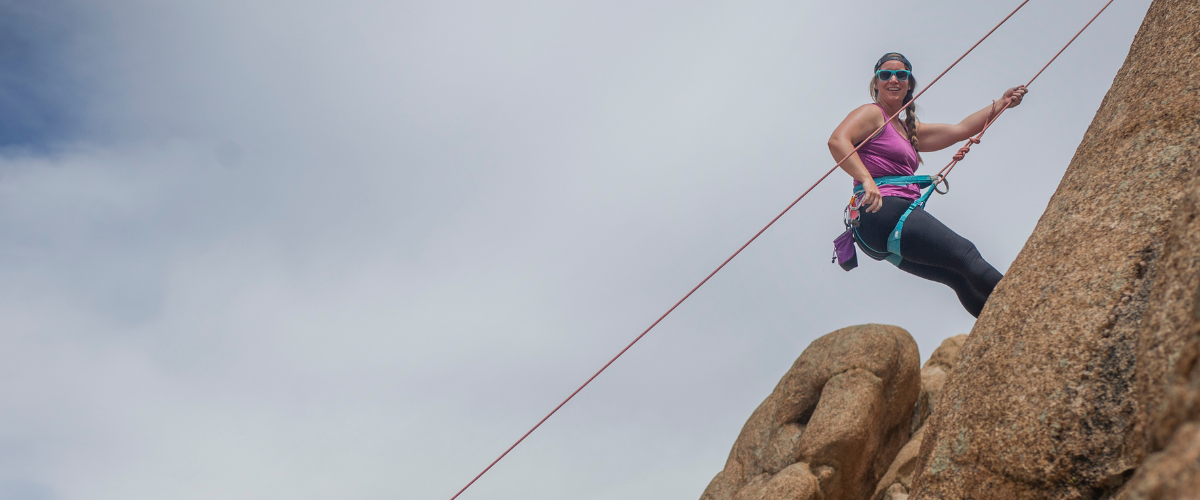Why Gym-To-Crag Programming is Valuable

Enthusiasts are flooding the sport of rock climbing, with their primary avenue to the sport being through the doors of indoor climbing gyms. There is a growing need for education to ease the transition to outdoor climbing, and gyms remain the leader in this arena.
Some skills we learn in the indoor climbing gym are easily transferable to the outdoor climbing world. Most require specified and technical learning unique to outdoor climbing, essential to ensuring safety, social responsibility, and having fun at the crag.
Indoor climbing gyms are by far the most common point of entry into the sport of rock climbing. Facilities are a natural fit for taking on the responsibility of providing this education to set their community up for success.
Article At A Glance |
|
In this article, we will discuss the importance of outdoor-focused education within indoor rock climbing gyms with expert input from American Mountain Guides Association (AMGA) Rock Guide and Owner of Peak Ascents Guiding Services, Dylan Connole. This will hopefully get your facility off on the right foot in providing these essential programmatic opportunities.
Many indoor climbing gyms already offer some level of gym-to-crag education, and these programs are often designed to help participants understand the introductory differences between gym and outdoor climbing. These can include technical differences, social differences, risk mitigation challenges, climbing skill differences, etc.
Regardless of the specific topic, there should be access to this type of education and some consistency in the approach and format of delivery.
READ ALSO: Non-Profit Member Spotlight: Access Fund
When Dylan Connole leads a gym-to-crag program, he prefers to organize the program into a two-day format. He splits his time between the gym and an outdoor setting.
Day one (in the gym) includes education about crag etiquette, how to find information about outdoor climbing areas and routes, and technical skills such as placing and cleaning quickdraws and building and cleaning sport climbing anchors. Then, day two of the program is a chance for participants to review what they have learned and practice it in an actual climbing setting under the supervision of a certified guide. I asked Dylan why this format is effective.
“The two-day format reinforces the skills that they learn. And when the second day is out at the crag, they get to practice these skills at height, in a real-world situation.”
Learning to clean a sport anchor with your feet safely on the ground in a temperature-controlled climbing gym is one thing, but doing it 60 feet off the ground when the wind is blowing and you can’t hear your belayer is another thing. Dylan says that if a crag day is not possible, a second day in the gym is the next best thing. Gym-to-crag programs can include countless topics and can focus on any number of skills, but these programs should always be taught by an expert who is certified and qualified to teach on the topic.
Gym-to-crag programs can provide general gym-to-crag education or be specific on what your community wants to learn. A place-based approach has great benefits for your clientele. If your gym is located in an area with a lot of outdoor bouldering, you could provide education focused on bouldering outdoors, the unique risks, the environmental impact, outdoor bouldering etiquette, etc.
Or, if your community members have shown interest in trad climbing, you could provide a program that focuses on equipment and technical skills such as gear placement, rope management, and anchor building. If you’re unsure what type of specific program would be the most valuable to your members, start by providing general gym-to-crag programs and specifying future programs based on participant feedback and recommendations from the community.
Dylan and I talked about the importance of this programming in climbing gyms. Dylan, who has been climbing for 18 years and guiding for four years, says, “There are a lot of new climbers joining climbing through gyms."
"When they want to start climbing outside, there needs to be access to education to help them transition safely.”
I asked him what the consequences of not offering this type of programming would be.
“There will be more underprepared climbers going outside and putting themselves and others in dangerous situations,” says Dylan.
With climbing gyms being the point of entry for most climbers, the opportunity to provide quality education for gym-to-crag skills should not be missed.
In addition to the responsibility to offer this type of programming, it also presents an excellent opportunity for beneficial community partnerships.
Gym-To-Crag Learning via CWA & Access Fund
The Climbing Wall Association is committed to providing resources for all climbing businesses and expanding climbing access across the world, primarily indoors but also outdoors. For this reason, we've prtnered with the Access Fund to give gyms tools they need to affordabl, and in a less risky way, implement gym-to-crag learning.
Climbing gyms can partner with local climbing guide services, access organizations, etc., to organize and provide these types of programs. Climbing gyms that partner with certified guides to expand their program offerings will be providing new value to their membership base, and the guide service will get the opportunity to work with potentially new clients while at the same time providing a broader value to the climbing community as a whole.
If your gym partners with your local access organization or climbers’ coalition, they can provide education that is specific to the area where your gym is located. For example, they can provide information about local crags, sharing public or private lands with different user groups or environmental impact issues specific to certain areas.
Providing these types of programs will hopefully help create an outdoor climbing scene that is sustainable long into the future as climbing’s popularity continues to grow.
Feel free to reach out to Headwall if you want to dig into this topic further, or want to share a gym-to-crag program success story, or if you would like to be connected with Dylan Connole to discuss his guiding services.
About the Headwall Group
 The Headwall Group was founded by Bix Firer and Pat Brehm. Bix Firer (MA, University of Chicago) is an Associate Professor of Outdoor Studies at Alaska Pacific University and has worked as a wilderness educator, trainer, facilitator, and experiential educator for over a decade.
The Headwall Group was founded by Bix Firer and Pat Brehm. Bix Firer (MA, University of Chicago) is an Associate Professor of Outdoor Studies at Alaska Pacific University and has worked as a wilderness educator, trainer, facilitator, and experiential educator for over a decade.
Pat Brehm works as a professional organizational trainer and has spent his career as a climbing coach, facilitator, and outdoor educator.
